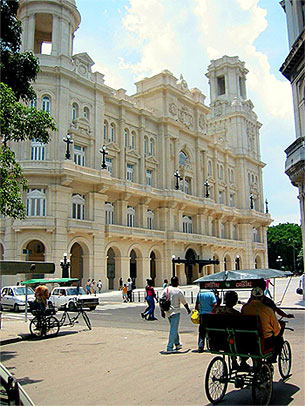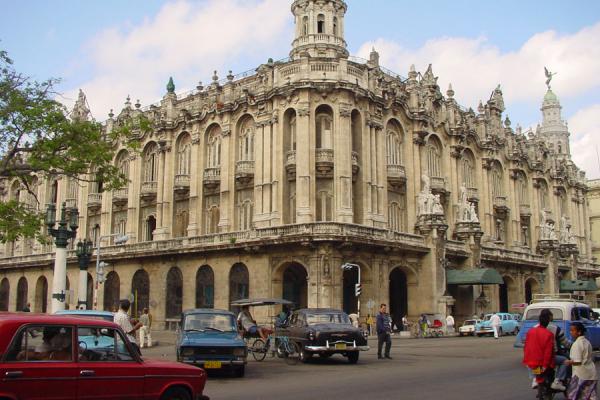
Playas del Este

Twenty-five minutes east of Havana are the Playas del Este, a chain of sandy beaches stretching for six miles (10km) between Bacuranao and Guanabo. At weekends they are generally packed with Cubans escaping the city. There are a few tourist hotels lining the coast, but other than that there are limited facilities. If needing an escape from the city the beaches make a good day trip, however those expecting pristine tropical island beaches might be disappointed.
Montemar Natural Park
Cuba is developing its eco-tourism potential, and one of the prime spots for getting back to nature is at the Montemar Natural Park on the Zapata Peninsula in the province of Matanzas (about 75 miles/120km from Havana). The peninsula is one of the largest swamps in the Caribbean, and its vast area includes forests, marshes, crystal clear lagoons and canals. Its exuberant flora, including more than 900 species of plants (115 of them endemic to Cuba) is complemented by its rich fauna, consisting of 160 bird species and 12 types of animal, including crocodiles. One of the park’s many features is the Laguna del Tesoro (Treasure Lagoon), a fresh water reservoir inhabited by golden trout. In the midst of the lagoon is a reproduction Taino village with its houses built on pillars. There are nature trails, a bird watching centre, and the largest flooded cave in Cuba. There is also a scuba centre, crocodile farm and several restaurants.
Museo de la Ciudad (Museum of the City)

The stately Baroque residence of Cuba's colonial governors and former Presidential Palace, the Palace of the Captains General built in 1791, stands as an impressive sight on the Plaza de Armas and is now the repository for the city's museum collections. The museum's displays and exhibits tell the tale of Havana, from its founding to the present day, including rooms devoted to the Cuban wars for national independence. The colourful Hall of Flags contains the original Cuban flag as well as a number of others used by the Spanish colonial government. There are also exhibits relating to archaeology, folklore and weaponry, and an art collection that includes porcelain, paintings and furniture of historic value and great beauty.
Cigar factories

Even non-smokers have to agree that a visit to Cuba would not be complete without investigating the island's most famous export, cigars. The art of cigar-making in Cuba is old and traditional, and three main factories in Havana offer tours for visitors to see cigars still rolled by hand. In the oldest factory, Partagas founded in 1827, traditionally a reader is employed to keep workers entertained while they fashion the famous cigars. Havana's other cigar factories are La Corona and the lesser-visited Romeo y Julieta. There are shops attached to the factories where cigars can be purchased. Visitors are advised not to buy cigars from people off the street as these are usually rolled banana leaves fashioned into cigar look-alikes and the sellers are persistent hustlers.
Plaza de la Revolución

Dominated by the imposing José Martí Memorial, the gigantic square has seen numerous political rallies, and the podium in front of the memorial is where important political figures like Fidel Castro have addressed more than a million Cubans on important occasions, such as 1 May and 26 July each year. At the foot of the memorial is a museum dedicated to José Martí, a national hero who would certainly have become Cuba's first president had he survived the Second War of Independence in 1895. It is possible to take the elevator to the top of the 138ft (42m) memorial, the highest structure in the city. Located behind the memorial are the closely guarded offices of Castro. Opposite the memorial on the far side of the square is the much-photographed Che Guevara image with the slogan Hasta la Victoria Siempre (Forever Onwards Towards Victory) that identifies the Ministry of the Interior building.
Museo Nacional de Bellas Artes

The modern Bellas Artes Museum is split into two buildings housing International and Cuban art. The Colección de Arte Universal covers everything from ancient Greek artefacts and Latin American pieces to art by French, Dutch and Italian painters. The Colección de Arte Cubano is also outstanding and covers works from the 16th to the 20th centuries by prominent Cuban artists.
Museo de la Revolución

Formerly the Presidential Palace and headquarters of the Cuban government, the impressive building now houses documents, photographs and artefacts pertaining to the Cuban Revolution and provides an excellent introduction to, and understanding of, Cuba's history and its struggle for independence. Prepare to spend a few hours wandering from room to room as the story unfolds from Spanish colonial times to the present day. In front of the museum entrance stands a watchtower that was part of the old city walls, as well as a tank used by Fidel Castro during the battle of the Bay of Pigs in 1961. Behind the museum is the glass-encased yacht, the 'Granma', which brought 82 revolutionaries, including Che Guevara and Fidel Castro, from Mexico to set the 1956 Revolution in motion.
Capitolio Nacional

One of Havana's grandest pieces of architecture, the Capitolio is an important landmark and one of Centro Habana's major sights. Resembling the US Capitol in Washington, DC, the monumental stone stairway leads to the vast domed hall from where tours will take visitors beyond the doors to elaborately decorated chambers that once housed the seat of Cuban Congress. Today it is home to the National Library and Academy of Sciences, and many of its rooms are still used for state events. Directly beneath the dome lies an imitation 24-carat diamond set into the marble floor, from where all highway distances between Havana and all sites in Cuba are measured.
Habana Vieja

This historic section of Cuba's capital was founded in 1519 and for centuries was an important naval port of colonial Spain. Being in such a strategic position the city was targeted by pirates and was fought over on numerous occasions and the ruins of the defensive walls that surrounded the city can still be seen. The Old City now also contains museums, hotels, restaurants and shops lining the original cobble-stoned streets. Surrounding the picturesque squares (plazas) are beautiful restored colonial buildings with grand facades, and striking churches that form a magnificent setting for the late afternoon chess and domino games and salsa music. Plaza de Armas was the seat of power in Cuba for 400 years, from where the Spanish Captain's General, US military governors and Cuban president were based, and today is home to an interesting book market. During the years of Prohibition in the United States, Habana Vieja turned into a playground for Americans who flocked here for the cheap liquor, gambling, prostitution and flamboyant lifestyle. One of the district's most famous bars is La Bodeguita Del Medio, which was the favoured haunt of legendary US writer, Ernest Hemingway.
Event
Havana Carnival

Parades and street parties, colourful costumes, wild dancing and traditional music. Cubans really know how to throw a party and for several weeks each year they do, the fun and frolics reaching high levels over weekends when the locals put their toil and trouble away and bring out the rum. Carnival comes with some traditions, like effigies of well known people being paraded along the coastal road, the Malecon, and the gaudy 'faroleros', decorated lamp posts carried aloft by dancers.
Havana Jazz Festival

Held every year, Havana's feast of jazz is eagerly awaited by fans around the world, offering four days of concerts, jam sessions and workshops. Many artists travel to Cuba to perform without any remuneration, the event having gained a prestigious reputation for quality and good organisation. Star of the show is Cuba's own Chucho Valdes, who usually performs with other local artists and international guests in the grand finale concert on the final night.
Transport
Airports
Jose Marti International Airport (HAV)
Location: The airport is situated 11 miles (18km) from Havana.
Transfer between terminals: A bus services the three terminals.
Transfer to the city: Taxis are available.
Car rental: Car rental is available from the Arrivals hall.
Facilities: Cadeca provides foreign exchange; bars, restaurants and shops, including duty-free, Internet access and travel agencies are also available.
Cubans rely heavily on an unreliable bus system that is cheap, but overcrowded and slow with long queues and inconsistent routes and schedules. Large buses called 'camellos' (camels, for their two humps) are pulled by truck engines and are particularly crowded, but very cheap (20 centavos). Most visitors to Havana avoid the buses and rely instead on numerous, inexpensive taxis to get around the greater part of the city. Renting a car is not the best option as car hire is expensive, roads are not well sign-posted, and numerous one-way streets make driving a real challenge. Different types of taxis cruise the streets, including tourist taxis, two-seater bici-taxis, colectivos (classic vintage cars) and the yellow scooter coco-taxis. Most tourist taxis are air conditioned, metered and well maintained and charge in Convertible Pesos, but there are also vintage car owners who operate as unofficial taxis, although a rate should be negotiated beforehand as passengers are likely to be overcharged. Bici-taxis, coco-taxis and colectivos are officially not supposed to take tourists. A couple of vintage cars can be hired by tourists for tours around the city and can be found outside main tourist attractions like the Revolution Museum or the Capitolio.

No comments:
Post a Comment